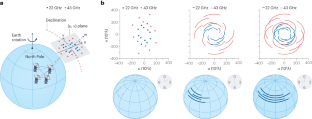Astronomical radio interferometry
IF 56
Q1 MULTIDISCIPLINARY SCIENCES
引用次数: 0
Abstract
Radio interferometry and its application to arrays of element antennas enable sensitive studies of celestial objects with angular resolutions comparable with, or surpassing, optical imaging at wavelengths thousands of times shorter. The aperture synthesis technique offers the advantage of improving the angular resolution by effectively creating a telescope as large as the greatest separation between array elements. This Primer introduces radio interferometry systems that receive cosmic electromagnetic signals at submillimetre to metre wavelengths. First, the concept of aperture synthesis, the basic instrumental components and the calibration of data are described with an overview of currently operational astronomical arrays. The process of image synthesis and the factors that need to be considered in producing a radio astronomy image are described and common data formats and software applications for processing observation data are introduced. Various factors that limit the capabilities and/or optimization of arrays are outlined. Future plans for radio interferometry are presented to close the Primer. Arrays of element antennas in radio interferometry enable the study of celestial objects with angular resolutions comparable with, or surpassing, optical imaging at wavelengths thousands of times shorter. In this Primer, Asaki et al. describe aperture synthesis, the basic instrumental components and data calibration.


天文射电干涉测量法
无线电干涉测量及其在元素天线阵列上的应用,使对天体的角分辨率的敏感研究能够与波长短数千倍的光学成像相媲美或超越。孔径合成技术通过有效地制造出与阵列元素之间最大间距一样大的望远镜,提供了提高角度分辨率的优势。本入门介绍了接收亚毫米到米波长的宇宙电磁信号的无线电干涉测量系统。首先,介绍了孔径合成的概念、基本仪器组成和数据校准,并概述了目前运行的天文阵列。介绍了射电天文图像的合成过程和制作射电天文图像需要考虑的因素,并介绍了处理观测数据的常用数据格式和软件应用。概述了限制阵列功能和/或优化的各种因素。提出了未来无线电干涉测量的计划,以关闭引物。
本文章由计算机程序翻译,如有差异,请以英文原文为准。
求助全文
约1分钟内获得全文
求助全文

 求助内容:
求助内容: 应助结果提醒方式:
应助结果提醒方式:


